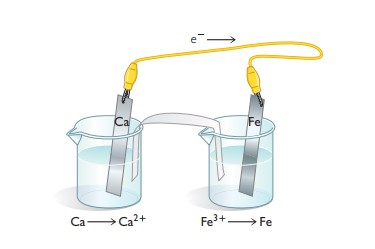
Concept explainers
(a)
Interpretation:The half-reactions for each beaker needs to be determined.
Concept Introduction : A
The half reactions are,
Given that, one beaker has a calcium metal electrode and a solution of aqueous calcium ions,
Therefore, the half reactions are,
(b)
Interpretation:The metal being oxidized and reduced needs to be determined.
Concept Introduction : A electrochemical reaction is marked by the presence of two half cells. The overall voltage is measured as the difference between the potentials of the half cells in an electrochemical cell.
Calcium is oxidized and iron is reduced.
The activity series of metal in the order of increasing reactivity is,
Gold < Silver < Mercury < Bismuth < Antimony < Hydrogen < Lead < Tin < Nickel < Cobalt < Cadmium < Iron < Chromium < Zinc < Manganese < Aluminium < Calcium < Strontium < Barium < Lithium < Sodium < Potassium
From the activity series it can be concluded that, calcium has is more active than iron. Hence, calcium is oxidized and iron is reduced.
(c)
Interpretation:A sketch of the electrochemical cell needs to drawn and the reaction that occur in each beaker needs to be shown.
Concept Introduction : A electrochemical reaction is marked by the presence of two half cells. The overall voltage is measured as the difference between the potentials of the half cells in an electrochemical cell.
A sketch of the electrochemical cell showing the reaction that occur in each beaker is given below:


Fig:A sketch of the electrochemical cell showing the reaction that occur in each beaker.
The half reactions on both the beakers are,
(d)
Interpretation:The net ionic equation for the reaction that takes place to generate electricity needs to be determined.
Concept Introduction:A electrochemical reaction is marked by the presence of two half cells. The overall voltage is measured as the difference between the potentials of the half cells in an electrochemical cell.
The net ionic equation is,
Given that, one beaker has a calcium metal electrode and a solution of aqueous calcium ions,
Therefore, the half reactions on the beakers are,
And the net ionic equation is obtained as:
So,
Chapter U5 Solutions
Living By Chemistry: First Edition Textbook
Additional Science Textbook Solutions
Chemistry: The Central Science (13th Edition)
Organic Chemistry (8th Edition)
Chemistry: A Molecular Approach (4th Edition)
Chemistry & Chemical Reactivity
Chemistry For Changing Times (14th Edition)
Chemistry: An Introduction to General, Organic, and Biological Chemistry (12th Edition) - Standalone book
 ChemistryChemistryISBN:9781305957404Author:Steven S. Zumdahl, Susan A. Zumdahl, Donald J. DeCostePublisher:Cengage Learning
ChemistryChemistryISBN:9781305957404Author:Steven S. Zumdahl, Susan A. Zumdahl, Donald J. DeCostePublisher:Cengage Learning ChemistryChemistryISBN:9781259911156Author:Raymond Chang Dr., Jason Overby ProfessorPublisher:McGraw-Hill Education
ChemistryChemistryISBN:9781259911156Author:Raymond Chang Dr., Jason Overby ProfessorPublisher:McGraw-Hill Education Principles of Instrumental AnalysisChemistryISBN:9781305577213Author:Douglas A. Skoog, F. James Holler, Stanley R. CrouchPublisher:Cengage Learning
Principles of Instrumental AnalysisChemistryISBN:9781305577213Author:Douglas A. Skoog, F. James Holler, Stanley R. CrouchPublisher:Cengage Learning Organic ChemistryChemistryISBN:9780078021558Author:Janice Gorzynski Smith Dr.Publisher:McGraw-Hill Education
Organic ChemistryChemistryISBN:9780078021558Author:Janice Gorzynski Smith Dr.Publisher:McGraw-Hill Education Chemistry: Principles and ReactionsChemistryISBN:9781305079373Author:William L. Masterton, Cecile N. HurleyPublisher:Cengage Learning
Chemistry: Principles and ReactionsChemistryISBN:9781305079373Author:William L. Masterton, Cecile N. HurleyPublisher:Cengage Learning Elementary Principles of Chemical Processes, Bind...ChemistryISBN:9781118431221Author:Richard M. Felder, Ronald W. Rousseau, Lisa G. BullardPublisher:WILEY
Elementary Principles of Chemical Processes, Bind...ChemistryISBN:9781118431221Author:Richard M. Felder, Ronald W. Rousseau, Lisa G. BullardPublisher:WILEY





